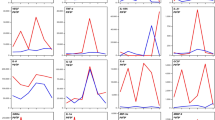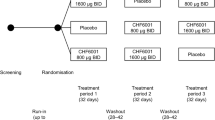Abstract
Introduction: COPD is characterized by bronchial neutrophilic inflammation. Clarithromycin is a macrolide antibiotic that has antibacterial and anti-inflammatory properties. Macrolide antibiotics have been shown to improve airway inflammation in diffuse pan-bronchiolitis but their role in COPD is undetermined. The aim of the study was to determine if 3 months of therapy with modified-release oral clarithromycin (Klaricid XL®) 500 mg/day reduced bronchial airway inflammation in patients with moderate-to-severe stable COPD compared with placebo.
Methods: A prospective, double-blind controlled trial randomized patients with moderate-to-severe stable COPD to 3 months’ therapy with oral modified-release clarithromycin 500 mg/day or placebo. Patients underwent saline sputum induction before and after treatment with clarithromycin. The effects of clarithromycin on sputum total cell and neutrophil counts, supernatant interleukin-8 (IL-8), leukotriene B4 (LTB4), tumor necrosis factor (TNF)-α, neutrophil elastase (NE), and neutrophil chemotaxis were assessed in comparison with placebo.
Results: Of a total of 67 patients included in the trial, 31 were treated with clarithromycin and 36 with placebo. The groups were similar in age, body mass index, history of smoking, and spirometry. Of 60 evaluable patients, 26 and 34 completed 3 months’ therapy with clarithromycin and placebo, respectively. Clarithromycin had no significant effect on sputum total cell count, neutrophil count, IL-8, LTB4, TNFα levels or neutrophil elastase. However, clarithromycin did cause a small reduction in the neutrophil differential (p = 0.04 relative to placebo) and neutrophil chemotaxis (p = 0.058 relative to placebo).
Conclusions: Oral clarithromycin 500 mg/day administered for 3 months had no significant effect on sputum neutrophil numbers or cytokine levels in patients with moderate-to-severe stable COPD. However, clarithromycin did cause a small reduction in the neutrophil differential and neutrophil chemotaxis. Further studies may be warranted to determine the clinical significance of these findings.



Similar content being viewed by others
Notes
1 The use of brand names is for product identification purposes only and does not imply endorsement.
References
The COPD Guidelines Group of the Standards of Care Committee of the BTS. BTS guidelines for the management of chronic obstructive pulmonary disease. Thorax 1997; 52Suppl. 5: S1–28
Keatings VM, Barnes PJ. Granulocyte activation markers in induced sputum: comparison between chronic obstructive pulmonary disease, asthma, and normal subjects. Am J Respir Crit Care Med 1997; 155: 449–53
Stockley RA. Neutrophils and protease/antiprotease imbalance. Am J Respir Crit Care Med 1999; 160: S49–52
Janoff A, Sloan B, Weinbaum G, et al. Experimental emphysema induced with purified human neutrophil elastase: tissue localization of the instilled protease. Am Rev Respir Dis 1977; 115: 461–78
Keatings VM, Collins PD, Scott DM, et al. Differences in interleukin-8 and tumor necrosis factor-alpha in induced sputum from patients with chronic obstructive pulmonary disease or asthma. Am J Respir Crit Care Med 1996; 153: 530–4
Hill AT, Bayley D, Stockley RA. The interrelationship of sputum inflammatory markers in patients with chronic bronchitis. Am J Respir Crit Care Med 1999; 160: 893–8
Cromwell O, Hamid Q, Corrigan CJ, et al. Expression and generation of interleukin-8, IL-6 and granulocyte-macrophage colony-stimulating factor by bronchial epithelial cells and enhancement by IL-1 beta and tumour necrosis factor-alpha. Immunology 1992; 77: 330–7
Calverley PM. Inhaled corticosteroids are beneficial in chronic obstructive pulmonary disease. Am J Respir Crit Care Med 2000; 161: 341–2
Barnes PJ. Inhaled corticosteroids are not beneficial in chronic obstructive pulmonary disease. Am J Respir Crit Care Med 2000; 161: 342–4
Labro MT, El Benna J, Babin-Chevaye C. Comparison of the in-vitro effect of several macrolides on the oxidative burst of human neutrophils. J Antimicrob Chemother 1989; 24: 561–72
Anderson R. Erythromycin and roxithromycin potentiate human neutrophil locomotion in vitro by inhibition of leukoattractant-activated Superoxide generation and autooxidation. J Infect Dis 1989; 159: 966–73
Anderson R, Theron AJ, Feldman C. Membrane-stabilizing, anti-inflammatory interactions of macrolides with human neutrophils. Inflammation 1996; 20: 693–70
Khair OA, Devalia JL, Abdelaziz MM, et al. Effect of erythromycin on Haemophilus influenzae endotoxin-induced release of IL-6. IL-8 and sICAM-1 by cultured human bronchial epithelial cells. Eur Respir J 1995; 8: 1451–7
Takizawa H, Desaki M, Ohtoshi T, et al. Erythromycin modulates IL-8 expression in normal and inflamed human bronchial epithelial cells. Am J Respir Crit Care Med 1997; 156: 266–71
Ichikawa Y, Koga H, Tanaka M, et al. Neutrophilia in bronchoalveolar lavage fluid of diffuse panbronchiolitis. Chest 1990; 98: 917–23
Kudoh S, Azuma A, Yamamoto M, et al. Improvement of survival in patients with diffuse panbronchiolitis treated with low-dose erythromycin. Am J Respir Crit Care Med 1998; 157: 1829–32
Kadota J, Sakito O, Kohno S, et al. A mechanism of erythromycin treatment in patients with diffuse panbronchiolitis. Am Rev Respir Dis 1993; 147: 153–9
Ichikawa Y, Ninomiya H, Koga H, et al. Erythromycin reduces neutrophils and neutrophil-derived elastolytic-like activity in the lower respiratory tract of bronchiolitis patients. Am Rev Respir Dis 1992; 146: 196–203
Fujii T, Kadota J, Kawakami K, et al. Long term effect of erythromycin therapy in patients with chronic Pseudomonas aeruginosa infection. Thorax 1995; 50: 1246–52
Sakito O, Kadota J, Kohno S, et al. Interleukin 1 beta, tumor necrosis factor alpha, and interleukin 8 in bronchoalveolar lavage fluid of patients with diffuse panbronchiolitis: a potential mechanism of macrolide therapy. Respiration 1996; 63: 42–8
Oda H, Kadota J, Kohno S, et al. Leukotriene B4 in bronchoalveolar lavage fluid of patients with diffuse panbronchiolitis. Chest 1995; 108: 116–22
Oda H, Kadota J, Kohno S, et al. Erythromycin inhibits neutrophil chemotaxis in bronchoalveoli of diffuse panbronchiolitis. Chest 1994; 106: 1116–23
Bhowmik A, Seemungal TA, Sapsford RJ, et al. Comparison of spontaneous and induced sputum for investigation of airway inflammation in chronic obstructive pulmonary disease. Thorax 1998; 53: 953–6
McGillivray DH, Burnett D, Afford SC, et al. An evaluation of four methods for the measurement of elastase activity. Clin Chim Acta 1981; 111: 289–94
Stockley RA, Bayley DL. Validation of assays for inflammatory mediators in sputum. Eur Respir J 2000; 15: 778–81
Falk W, Goodwin RH, Leonard EJ. A 48-well micro chemotaxis assembly for rapid and accurate measurement of leukocyte migration. J Immunol Methods 1980; 33: 239–47
Harvath L, Falk W, Leonard EJ. Rapid quantitation of neutrophil chemotaxis: use of a polyvinylpyrrolidone-free polycarbonate membrane in a multiwell assembly. J Immunol Methods 1980; 37: 39–45
Jepsen LV, Skottun T. A rapid one-step method for the isolation of human granulocytes from whole blood. Scand J Clin Lab Invest 1982; 42: 235–8
Jaffe A, Francis J, Rosenthal M, et al. Long-term azithromycin may improve lung function in children with cystic fibrosis. Lancet 1998; 351: 420
Wolter J, Seeney S, Bell S, et al. Effect of long term treatment with azithromycin on disease parameters in cystic fibrosis: a randomised trial. Thorax 2002; 57: 212–6
Equi A, Balfour-Lynn IM, Bush A, et al. Long term azithromycin in children with cystic fibrosis: a randomised, placebo-controlled crossover trial. Lancet 2002; 360: 978–84
Ordonez CL, Stulbarg M, Grundland H, et al. Effect of clarithromycin on airway obstruction and inflammatory markers in induced sputum in cystic fibrosis: a pilot study. Pediatr Pulmonol 2001; 32: 29–37
Brennan S, Cooper D, Sly PD. Directed neutrophil migration to IL-8 is increased in cystic fibrosis: a study of the effect of erythromycin. Thorax 2001; 56: 62–4
Miyajima M, Suga M, Nakagawa K, et al. Effects of erythromycin on experimental extrinsic allergic alveolitis. Clin Exp Allergy 1999; 29: 253–61
Yamaryo T, Oishi K, Yoshimine H, et al. Fourteen-member macrolides promote the phosphatidylserine receptor-dependent phagocytosis of apoptotic neutrophils by alveolar macrophages. Antimicrob Agents Chemother 2003; 47: 48–53
Honeybourne D, Kees F, Andrews JM, et al. The levels of clarithromycin and its 14-hydroxy metabolite in the lung. Eur Respir J 1994; 7: 1275–80
Burge PS, Calverley PM, Jones PW, et al. Randomised, double blind, placebo controlled study of fluticasone propionate in patients with moderate to severe chronic obstructive pulmonary disease: the ISOLDE trial. BMJ 2000; 320: 1297–303
Jarad NA, Wedzicha JA, Burge PS, et al. An observational study of inhaled corticosteroid withdrawal in stable chronic obstructive pulmonary disease. ISOLDE Study Group. Respir Med 1999; 93: 161–6
Van der Valk P, Monninkhof E, Van der Palen J, et al. Effect of discontinuation of inhaled corticosteroids in patients with chronic obstructive pulmonary disease: the COPE study. Am J Respir Crit Care Med 2002; 166: 1358–63
Rutgers SR, Timens W, Kaufmann HF, et al. Comparison of induced sputum with bronchial wash, bronchoalveolar lavage and bronchial biopsies in COPD. Eur Respir J 2000; 15: 109–15
Maestrelli P, Saetta M, Di Stefano A, et al. Comparison of leukocyte counts in sputum, bronchial biopsies, and bronchoalveolar lavage. Am J Respir Crit Care Med 1995; 152: 1926–31
Woolhouse IS, Bayley DL, Stockley RA. Effect of sputum processing with dithiothreitol on the detection of inflammatory mediators in chronic bronchitis and bronchiectasis. Thorax 2002; 57: 667–71
Suzuki T, Yanai M, Yamaya M, et al. Erythromycin and common cold in COPD. Chest 2001; 120: 730–3
Kadota J, Mukae H, Ishii H, et al. Long-term efficacy and safety of clarithromycin treatment in patients with diffuse panbronchiolitis. Respir Med 2003; 97: 844–50
Acknowledgements
The research of Dr Banerjee was funded by a research grant from Abbott Laboratories Ltd, Maidenhead, UK.
The authors would like to thank Professor R. Stockley, Dr S. Hill, and Mr D. Bayley for their technical supervision of the laboratory procedures.
Author information
Authors and Affiliations
Corresponding author
Rights and permissions
About this article
Cite this article
Banerjee, D., Honeybourne, D. & Khair, O.A. The Effect of Oral Clarithromycin on Bronchial Airway Inflammation in Moderate-to-Severe Stable COPD. Treat Respir Med 3, 59–65 (2004). https://doi.org/10.2165/00151829-200403010-00007
Published:
Issue Date:
DOI: https://doi.org/10.2165/00151829-200403010-00007




